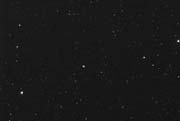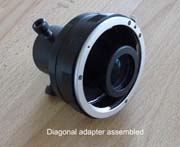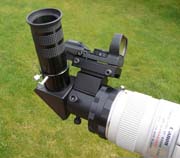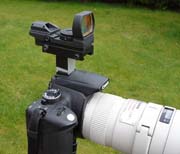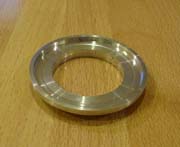As the Eclipse/Southern Hemisphere trip in June/July 2010 grew closer, I became increasingly concerned about the weight problems in taking a rig using my Series 5000 80 mm refractor on my EQ3-2 mount. I considered a premium small refractor, but after considerable web browsing, I invested in the superb Canon EF 400 f5.6L prime telephoto lens. I also managed to reduce the size of the guiding system by using a small 300mm fl mirror lens which strangely although supposedly M42 lens thread screwed easily into the 'T' threaded XY guider without an adapter.
Total weight saving a little over 3 Kg. Doesn't sound much, but with airline weight restrictions....
The lens has a built in retracting hood about 75 mm deep when extended - very useful for protection and stray light exclusion as well as dew prevention. The rig as shown here is in deep sky guiding mode, but for the eclipse photography only the 400L will be used.
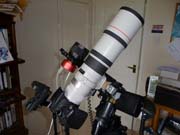
Of course having bought the 400L lens, I had to test it with the Canon 350D camera. A sequence of 15 x 5 minute sub frames, ISO 800 at f6.3 yielded this shot of M81 and M82. Early hours of 12th April 2010.
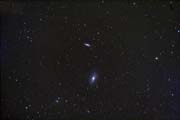
By introducing a Barlow lens into the imaging train it is possible to use a diagonal and eyepiece with a camera lens. So I fired up my lathe and made an connecter using the bayonet adapter and other parts of a remarkably cheap but well made extension tube macro ring.
These are readily available on the Internet, particularly Amazon and ebay. Search for 'Macro Extender', be sure to get the correct pattern for your make of camera lens. No need for one with internal wiring. Works well, and I was also able to make a fitting to use the lens with my ST4000 XCM. Unfortunately not enough back focus for the ST-10 with filter wheel.
The focal length of the lens with the Barlowed system is around 1300 mm, so a finder is necessary. There was just enough room to fit a red dot unit on the unit! I had earlier cobbled up a finder mounting block for my camera as also seen in the main picture, so all set :-)

A further experiment with the 400L lens bore fruit! The already good photographs are even sharper when the lens is stopped down to f6.3 or even f7.1 But this introduces substantial diffraction 'Star bursts' on bright stars due to the diaphragm blades. I found that by stopping down the lens using an external mask I obtained images even cleaner than with the diaphragm, and without star bursts. A modified lens cap makes an excellent removable mask, and has the advantage that if I am using the lens with my ST-4000XCM I don't need the Canon camera available to preset the stop.
The star featured here is 2nd magnitude eta Bootis. This system seems to work well on most prime lenses, but experiments with zoom lenses showed substantial vignetting.

Postscript. Would you believe after all that work (and expense!) that shortly before the trip I was informed that our luggage allowance was almost twice that originally expected. So no need for the weight worries and I could have stayed with the 80 mm telescope! But in the end I didn't take the 80 mm - even with three suitcases our weight was on the limit for each case, and four cases would have been unmanageable when travelling, particularly in the Motor Caravan in New Zealand! Furthermore, as I later found out when photographing the Eclipse, the longer 480 mm focal length of the 80mm telescope would have been barely large enough to encompass the whole corona - the 400 mm lens is ideal with an APS size sensor.
Much later - November 2010. As I mention above, the adapter I made to connect the bayonet fitting to my ST4000 did not work on my ST-10 with filter wheel, not enough back focus. But some experiments with spacing gave me to believe it might *just* be possible with a different design, which necessitated cutting down the bayonet fitting and epoxying a 'T' threaded adapter inside it. So I bought another macro extension assembly to get a bayonet fitting and set to.
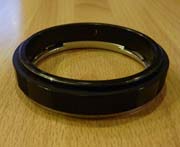
I made a drawing to keep me right. The 54 mm diameter is adjusted during manufacture to fit inside the bayonet unit with a tiny clearance for adhesive, and of course is particular to that make of bayonet ring. It was necessary to recess the inside to clear the electronics of the lens, so only 0.5 mm is available for the web. But in the end it proved strong enough, even in the Aluminium I used. Although the epoxied rim is only 2.9 mm thick, in fact the total glued area is almost 5 sq. cm.
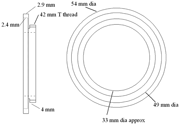
Back and front views of the finished insert. Well, actually a discarded one - wrong thread pitch, I misread one of the gear wheels on my lathe. Oops. But the next effort was ok!.

And this is the finished adapter with a coat of matt black paint to minimise reflections. Total effective thickness (excluding the 'T' thread which obviously disappears inside the filter wheel faceplate) is 8.3 mm. The spring for the lens locking button was discarded - the reduction in thickness of the original unit broke through into the mounting hole for the spring. But it still works with care!

Ready for action! The assembly *just* reaches focus with the 400L lens with a tiny bit to spare. I had hoped to use it also with my Tamron 17-50 mm lens, but it was not to be - not quite enough adjustment on the lens. Pity, but at least I can use the excellent 400L. I would need a different housing for the filter wheel to reach focus with the 17-50. Possibly available from SBIG, but no news at the time of setting this up (November 2010)
Later (Spring 2012) My new QSI camera WILL reach focus with the 17-50 lens - it requires slightly less back focus than the SBIG camera. But that is without the built in off-axis guider, so a seperate guide camera is required.
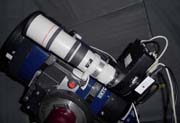
Because of the greater likelihood of bright stars appearing in the wide field of the 400 mm focal length and blooming excessively with the ST-10 camera, in many cases the lens will be more suitable for use on the ST-10 with a Hydrogen-alpha filter. And here is a test shot of the region around Messier 57. 12nm H-a filter, 5 x 2 minute subs, f7.1 external mask , unguided on the G41 mount.
